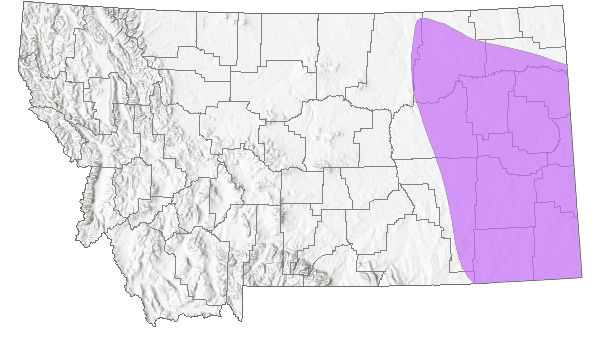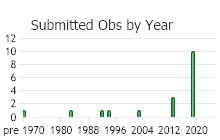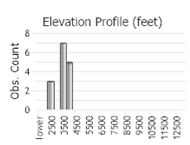View in other NatureServe Network Field Guides
NatureServe
Montana
Utah
Wyoming
Idaho
Wisconsin
British Columbia
South Carolina
Yukon
California
New York
Lead Plant - Amorpha canescens
State Rank Reason (see State Rank above)
Amorpha canescens was documented in 1922 and 1948 from Carter County (Lockhart 25, USFS-RM; Booth 2675, MONT). From 1983 to 2013 various field projects reported another 8 locations of Amorpha canescens, but provided no specimens or photographs to validate the identifications. A cursory survey of the 1922 location did not find any plants in 2021. A 1984 search to re-locate the plants found at the 1948 location was unsuccessful. In 2019 surveys on the Custer-Gallatin National Forest found and verified 10 sites in Montana (Hansen 196 and 264, MONTU; Hansen 2019). The 2019 observations found healthy, reproductive plants with no apparent threats. Relative to the State of Montana Amorpha canescens is ranked as a Species of Concern because it occupies relatively little habitat and almost half of the reported observations need to be validated before re-assessing its state status.
General Description
PLANTS: A rhizomatous shrub that grows 20-80 cm tall, but can experience die-back. Simple to sparingly branched stems grow erect to ascending. Plants have soft, interwoven hairs (tomentose), but become less hairy (glabrate) with age; this can give the plant a hoary appearance. Sources: Lesica et al. 2012; McGregor et al. 1986.
LEAVES: Alternately arranged on the stem. Leaves have short petioles and are pinnately-divided into 13-21 mm leaflets. Leaflets are oblong, 8-15 mm long with smooth (entire) margins, and covered with soft, short, grayish-white hairs (canescent). Sources: Lesica et al. 2012; McGregor et al. 1986.
INFLORESCENCE: Violet flowers are arranged in racemes that appear like a spike. Narrow, racemes are 7-15 cm long, arise from leaf axils, and are subtended by pubescent bracts. Collectively, sepals (calyx) are cone-shape (obconic). The 5 sepals are 3.5 mm long with sessile glands and dense hairs. The single petal is reduced to the banner, 4-6 mm long, and encloses the stamens. Stamens are 10, orange, united at their base, and extend beyond the petal. Pistil is single and superior. Fruit is a 1-seeded legume, 3-4 mm long, canescent with sessile glands, and has a long beak. Sources: Lesica et al. 2012; McGregor et al. 1986.
Phenology
Flowering from late June to mid July; fruiting through summer.
Plants found in Carter County during August 2019 were mature and in flower and producing seed (Hansen 2019).
Diagnostic Characteristics
Dalea and
Psoralea have similar looking leaves, but plants are herbaceous with flowers that have more than one petal.
Montana has several woody plants in the Pea or Fabaceae family:
Lead Plant -
Amorpha canescens, Native, SOC
*Habit: Relatively shorter shrub.
*Leaves: Pinnately divided with more than 10 leaflets.
*Hairs: Short, dense, and whitish-gray (canescent).
*Flowers: Corolla consists of 1 violet petal reduced to a banner.
Siberian Pea Tree -
Caragana arborescens, Exotic
*Habit: Highly branched, medium to tall shrub.
*Leaves: Even-pinnately divided 4-10 leaflets.
*Hairs: Pubescent.
*Flowers: Yellow with 4 petals, papilionaceous.
Scotch Broom -
Cytisus scoparius, Noxious
*Habit: Medium to tall shrub.
*Leaves: Pinnately divided with 1-3 leaflets.
*Hairs: glabrous to pubescent.
*Flowers: Bright yellow with 4 petals, papilionaceous.
Black Locust -
Robinia pseudoacacia, Introduced
*Habit: Trees up to 20 meters tall.
*Leaves: Odd-pinnately divided with 9-17 leaflets.
*Hairs: Sparse hairs (puberulent) to nearly hairless (glabrate).
*Corolla consists of 1 violet petal reduced to a banner.
Species Range
Montana Range
Range Descriptions

 Native
Native
Range Comments
Montana to Manitoba south to New Mexico, Texas, and Illinois (Lesica et al. 2012). In the Great Plains and becoming infrequent westward (McGregor et al. 1986).
In Montana, Lead Plant was collected in 1922 and in 1948 from Carter County (Lockhart 25, USFS-RM; Booth 2675, MONT). It was not until 2019 that Lead Plant was re-discovered and verified (https://www.pnwherbaria.org/; Hansen 2019). However, many reports from various counties from 1983 to 2013 have been made, but lack any documentation.
Observations in Montana Natural Heritage Program Database
Number of Observations: 21
(Click on the following maps and charts to see full sized version)
Map Help and Descriptions
Relative Density

Recency



 (Observations spanning multiple months or years are excluded from time charts)
(Observations spanning multiple months or years are excluded from time charts)
Habitat
In Montana plants occur in grasslands and woodlands where soils are often sandy soil within the Plains zone (Lesica et al. 2012).
Based on the 2019 observations, Lead Plant was found at elevations ranging from approximately 3,960 to 4,080 feet on slopes ranging from 5 to 40 percent (Hansen 2019). The ridges have soils consisting of mixed sands and gravels mainly in the Reeder-Cabba loams 4-15% slopes, Belltower-Dast-Reeder complex 15-35% slopes, and little bit in Parshall-Cohagen fines sandy loam 4-15% slopes (Hansen 2019).
National Vegetation Classification System Groups Associated with this Species
Forest and Woodland
Low Elevation - Xeric Forest and Woodland
Grassland
Lowland - Prairie Grassland
Ecology
POLLINATORSThe following animal species have been reported as pollinators of this plant species or its genus where their geographic ranges overlap:
Bombus pensylvanicus and
Bombus griseocollis (Colla and Dumesh 2010).
LAND USEIn the Great Plains, Lead Plant is one of the most palatable range plants (McGregor et al. 1986). Plants decrease with grazing, becoming rare in overgrazed habitats (McGregor et al. 1986). In pastures and meadows where it is mowed, plants grow as herbaceous perennials, but in undisturbed grasslands plants can become tall shrubs (McGregor et al. 1986).
Plants found during 2019 in Carter County were growing within grazing allotments that have been in effect for many decades (Hansen 2019). At the time of the August observations cattle were not present and no grazing of the plants was observed. All sites had burned in the 1988 Brewer Fire with moderate-high intensity and also in the 2002 Kraft Springs fire with low-moderate intensity (Hansen 2019). The sites are naturally regenerating with Ponderosa Pine (
Pinus ponderosa); one site is being colonized by Quaking Aspen (
Populus tremuloides) which seem to be recently expanding in the Long Pines area southeast of Ekalaka, Montana (Hansen 2019).
Stewardship Responsibility
Threats or Limiting Factors
STATE THREAT SCORE REASON
Reported threats to Montana’s populations of Lead Plant include the presence of noxious weeds, but the impact was found to be negligible, which results in an unassigned State Threat Score (MTNHP Threat Assessment 2021).
References
- Literature Cited AboveLegend:
 View Online Publication
View Online Publication Colla, S.R. and S. Dumesh. 2010. The bumble bees of southern Ontario: notes on natural history and distribution. Journal of the Entomological Society of Ontario 141:39-68.
Colla, S.R. and S. Dumesh. 2010. The bumble bees of southern Ontario: notes on natural history and distribution. Journal of the Entomological Society of Ontario 141:39-68. Hansen, Kurt. 2019. Leadplant, Amorpha canescens, occurrences on the Sioux Ranger District, Custer Gallatin National Forest, Carter County, MT and Harding County, SD. August 2019. U.S. Department of Agriculture, Forest Service.
Hansen, Kurt. 2019. Leadplant, Amorpha canescens, occurrences on the Sioux Ranger District, Custer Gallatin National Forest, Carter County, MT and Harding County, SD. August 2019. U.S. Department of Agriculture, Forest Service. Lesica, P., M.T. Lavin, and P.F. Stickney. 2012. Manual of Montana Vascular Plants. Fort Worth, TX: BRIT Press. viii + 771 p.
Lesica, P., M.T. Lavin, and P.F. Stickney. 2012. Manual of Montana Vascular Plants. Fort Worth, TX: BRIT Press. viii + 771 p. McGregor, R.L. (coordinator), T.M. Barkley, R.E. Brooks, and E.K. Schofield (eds). 1986. Flora of the Great Plains: Great Plains Flora Association. Lawrence, KS: Univ. Press Kansas. 1392 pp.
McGregor, R.L. (coordinator), T.M. Barkley, R.E. Brooks, and E.K. Schofield (eds). 1986. Flora of the Great Plains: Great Plains Flora Association. Lawrence, KS: Univ. Press Kansas. 1392 pp. MTNHP Threat Assessment. 2021. State Threat Score Assignment and Assessment of Reported Threats from 2006 to 2021 for State-listed Vascular Plants. Botany Program, Montana Natural Heritage Program, Helena, Montana.
MTNHP Threat Assessment. 2021. State Threat Score Assignment and Assessment of Reported Threats from 2006 to 2021 for State-listed Vascular Plants. Botany Program, Montana Natural Heritage Program, Helena, Montana.
- Additional ReferencesLegend:
 View Online Publication
View Online Publication
Do you know of a citation we're missing? Heidel, B.L. and H. Marriott. 1996. Sensitive plant species survey of the Ashland District, Custer National Forest, Powder River and Rosebud Counties, Montana. Unpublished report to the U.S. Forest Service. Montana Natural Heritage Program, Helena, Montana. 94 pp. plus appendices.
Heidel, B.L. and H. Marriott. 1996. Sensitive plant species survey of the Ashland District, Custer National Forest, Powder River and Rosebud Counties, Montana. Unpublished report to the U.S. Forest Service. Montana Natural Heritage Program, Helena, Montana. 94 pp. plus appendices. Lesica, P., M.T. Lavin, and P.F. Stickney. 2022. Manual of Montana Vascular Plants, Second Edition. Fort Worth, TX: BRIT Press. viii + 779 p.
Lesica, P., M.T. Lavin, and P.F. Stickney. 2022. Manual of Montana Vascular Plants, Second Edition. Fort Worth, TX: BRIT Press. viii + 779 p. Vanderhorst, J.P., S.V. Cooper, and B.L. Heidel. 1998. Botanical and vegetation survey of Carter County, Montana. Unpublished report prepared for the Bureau of Land Management. Montana Natural Heritage Program, Helena. 116 pp. + app.
Vanderhorst, J.P., S.V. Cooper, and B.L. Heidel. 1998. Botanical and vegetation survey of Carter County, Montana. Unpublished report prepared for the Bureau of Land Management. Montana Natural Heritage Program, Helena. 116 pp. + app.
- Web Search Engines for Articles on "Lead Plant"





